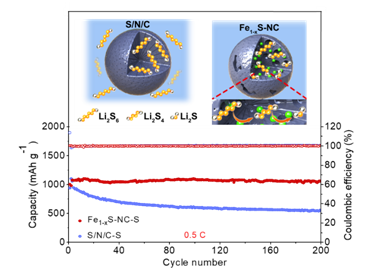Recently, two teams of researchers from the Micro-Nanoreactor and Reaction Engineering Science group (05T7) headed by Prof. Liu Jian and the 2D Materials and Energy Devices Research group (DNL21T3) directed by Prof. Wu Zhong Shuai, developed Fe1-xS-decorated mesoporous carbon spheres as nanoreactors for application as lithium sulfur battery cathode. The nanoreactor, as a positive electrode substrate of a lithium-sulfur battery, has obtained excellent polysulfide catalytic activity and cycle stability. Relevant research results were published in Advanced Energy Materials.
Lithium-sulfur battery has a high theoretical energy density of 2600 Wh kg-1 and theoretical capacity of 1675 mAh g-1. They are considered to be a high-energy battery with great application prospects. However, due to the slow conversion reaction dynamics of sulfur in the process of charging and discharge, the utilization rate of sulfur is low and the shuttle effect is serious. This makes the capacity and stability of lithium sulfur battery low and as such, the practical application of lithium sulfur battery is greatly limited. Therefore, how to rationally design the electrocatalytic system to efficiently and stably achieve the catalytic conversion of polysulfides under high-load sulfur conditions, and to increase the capacity and life of lithium-sulfur batteries is one of the bottlenecks in the development of lithium-sulfur batteries.

In this work, the two teams worked intensively to address the scientific problems and key technical bottlenecks of lithium-sulfur batteries, developed molecular-scale S-doped porous carbon spheres, and further achieved carbon nanospheres with embedded Fe1-xS particles as electrocatalyst For application as lithium-sulfur battery cathode, we used the nanoreactor to construct a sulfur cathode composite material with high catalytic activity and high sulfur loading. Experiments show that the nanoreactor has a low mass density, high porosity, and highly dispersed electrocatalyst, which significantly improves the ability to adsorb and catalyze the conversion of polysulfides. The resulting battery achieves a capacity retention of 1070 mAh g-1 at a current density of 0.5 C and experiences almost no attenuation after 200 cycles. At the same time, in collaboration with Cai Qiong's team at the University of Surrey, the importance of Fe1-xS particle-supported carbon sphere nanoreactors to enhance the synergistic effect of chemisorption and redox kinetics of polysulfides was theoretically demonstrated. This design strategy of nanoreactor structure is of great significance for the construction of energy devices based on multi-electron conversion reactions, such as metal sulfur batteries.
